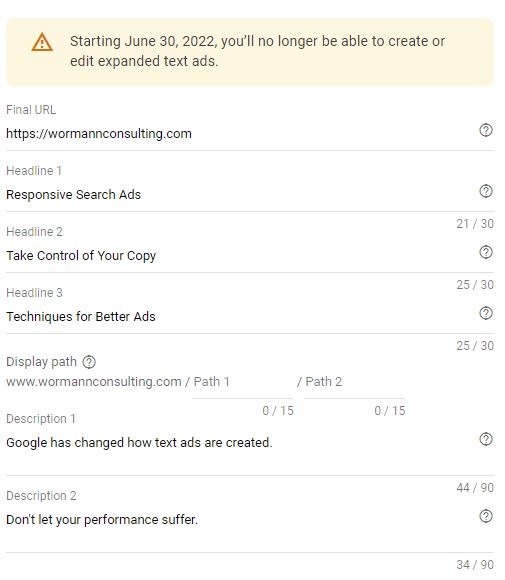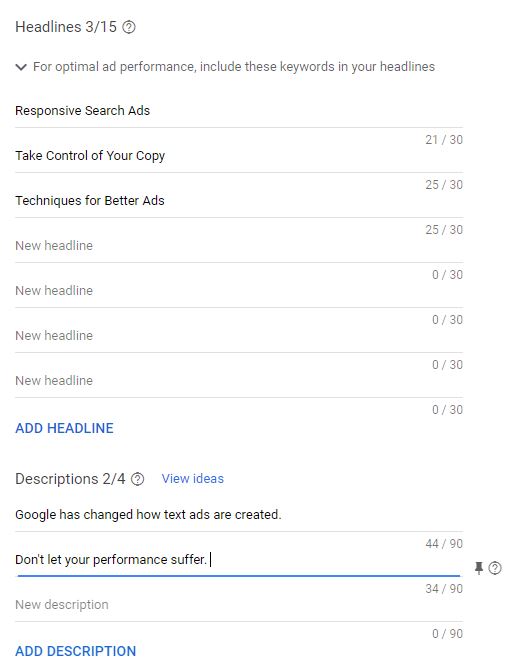According to a recent announcement by Google, they will be sunsetting Expanded Text Ads in the Google Ads platform. Expanded search ads are what people usually consider the “default” search ads, consisting of 3 headlines (30 characters) and 2 description lines (90 characters). In place of this, the new “default” text ads will be Responsive Search Ads. Responsive search ads allow a user to enter up to 15 headlines which Google will select from in showing your ad.
This is pretty big news because if you don’t know what you’re doing, this could have a significant negative impact on your ad performance. It doesn’t have to though. Below, we’ll give the “CliffsNotes” version of the changes and the strategies that will help you get through the changes without having your performance dinged.
Google’s Transition to Responsive Ads
Originally, text ads had 2 headlines and a description line. This was later increased to 3 headlines and 2 description lines and called “Expanded Text Ads.” Google later added Responsive Search Ads in order to increase flexibility within ads. These have up to 15 headlines and up to 4 description lines that Google chooses from based on the search query and user intent. These ads then become much more flexible, but there is also a lack of control.
Below are examples of Expanded Text Ads and Responsive Search Ads to illustrate the difference:

Example of Expanded Text Ads

Example of Responsive Ad
Back in February, Google made Responsive Search Ads the default ad type, though you could still make Expanded Text Ads. With this new announcement, as of June 30, 2022 users will no longer be able to create or edit any Expanded Text Ads – everything will go to Responsive Search Ads. As of now, it is believed that existing ads will still be able to run. However, we do not know for sure that this will be the case due to the nature of Google’s changes.
The Issues with Responsive Ads
There are a couple of issues that come up with responsive ads, and they significantly outweigh the potential benefits. Ultimately, what is happening is that Google is trying to push automation and remove control from the users. In the past they’ve done this with descriptions in organic search results, and recently started showing different titles in search results than website owners indicated, and the results were not good. Google’s machine learning is very impressive, but it is not good enough (at least at this time) to replace the human understanding that goes into writing this text for the user. We have run tests with responsive search ads, and they are outperformed by expanded text ads almost every single time.
Most of the time, ads are written to have a very specific flow from one line to the next. Responsive ads change the order, and can ultimately cause ads to make less sense. While the correct terms may appear in the ad, the lack of flow leads to poorer performance. The loss of control has a direct correlation with performance.
Another big issue comes in regulated areas like pharmaceuticals and law, where specific approvals are needed and language is very important. Google changing the way that ads are shown can have direct correlation on compliance issues, or simply create a nightmare of an approval process.
Creating Ads that Still Perform
While the changes are inevitable, there are still some things you can do now to help increase your campaigns performance. There are two things that we will be rolling out for our clients to help stay ahead of the changes:
- Create evergreen Expanded Text Ads now. As you won’t be able to create new Expanded Text Ads in the future, it’s a good idea to create some general ads now and keep them paused. If you’d like to activate them in the future, you can and they’ll all be ready. Since you cannot edit them, a handful of variations are recommended that are likely to be useful in the long term (i.e. not sale related products that may be discontinued, or anything too specific.)
- Used pinned placements. In Responsive Search Ads, there is a “pinning” option right next to each headline and description (the icon looks like a thumbtack). This allows you to pin a certain headline to a certain position. For example “always show this line as the second line.” This helps to control the flow of the ads more than the default. However, you can create a responsive text ad with just three headlines and two description lines all pinned to one specific slot, essentially creating an Expanded Text Ad. Google typically doesn’t favor pinned placements so there may be a slight performance decline, but it is worth testing in your specific ads when the time comes to see the results and adjust accordingly.
Getting Help with Your Ads
We understand that changes create confusion. When you aren’t spending most of your day in Google Ads, changes become even more of an issue – even when the intent is to simplify your life. If you need help, let us know. We work with both companies and agencies to help them maximize their PPC performance every day and get the most for their money. Contact us to set up an initial meeting, and we’ll talk through how we can help you navigate through the world of Google Ads.

